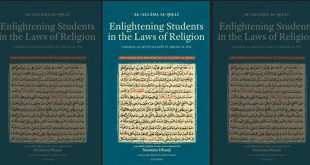The book “Rule-Formulation and Binding Precedent in the Madhhab-Law Tradition: Ibn Quṭlūbughā’s Commentary on The Compendium of Qudūrī”is, at once, a work of intellectual, social, and legal history.
This book “Rule-Formulation and Binding Precedent in the Madhhab-Law Tradition: Ibn Quṭlūbughā’s Commentary on The Compendium of Qudūrī” examines how the interaction of learned traditions, scholarly networks, and legal instructions informed the development of a ‘madhhab-law’ system of jurisprudence underpinning the four post-classical Sunni madhhabs. By taking a commentary written by a late Mamluk jurist as its case study, this book analyses how commentaries wove an intricate tapestry inttelctual diversity while notion of binding precedent and other jurisprudential theories which medieval jurisprudents developed in response to the institutional needs of their age. Thus, what is ostensibly a mere commentary of fiqh actually provides us with insight into how authors reacted to, and interacted with, other scholars over space and time; and how rich-perhaps bewildering –bodies of knowledge could be made intelligible and operational for judges, muftis and teachers of jurisprudence.
In Rule-Formulation and Binding Precedent in the Madhhab-Law Tradition, Talal Al-Azem argues for the existence of a madhhab-law tradition’ of jurisprudence underpinning the four post-classical Sunni schools of law.
This tradition celebrated polyvalence by preserving the multiplicity of conflicting opinions within each school, while simultaneously providing a process of rule formulation (tarjīḥ) by which one opinion is chosen as the binding precedent (taqlīd). The predominant forum of both activities, he shows, was the legal commentary.
Through a careful reading of Ibn Quṭlūbughā’s (d. 879/1474) al-Taṣḥīḥ wa-al-tarjīḥ, Al-Azem presents a new periodisation of the Ḥanafī madhhab, analyses the theory of rule formulation, and demonstrates how this madhhab-law tradition facilitated both continuity and legal change while serving as the basis of a pluralistic Mamluk judicial system.
About the Author:
Talal Al-Azem, DPhil (2011), University of Oxford, is the Mohammed Noah Fellow at the Oxford Centre for Islamic Studies. His research focuses on traditions of law and learning in the medieval and early modern Muslim world.
Table of contents
Introduction
Chapter 1 Authors
A The compendium author: Qudūrī
B The commentator: Ibn Quṭlūbughā
Chapter 2 History
A Ibn Quṭlūbughā’s sources
B Periodisation
Period 1: Foundational ‘Ḥanafī’ opinions (ca. 150–200)
Period 2: Formative transmission (ca. 200–300)
Period 3: Classical consolidation (ca. 300–400)
Period 4: Tarjīḥ (ca. 400–650)
Period 5: Taṣḥīḥ (ca. 650–870)
Who are the ‘latter-day jurists’ (al-muta’akhkhirūn)?
C Historical geographical patterns
D Periodisation and the typologies of jurists (ṭabaqāt al-fuqahā’)
Chapter 3 Theory
A Ibn Quṭlūbughā’s introduction to al-Taṣḥīḥ wa-al-tarjīḥ
B Analysis of the topics
1 Definitions
2 The procedures of rule-determinacy
3 Judicial discretion
C Arguments for binding precedent
1 The ethico-religious argument
2 The argument from legal-system consistency
3 The argument from legal-system coherence
4 The argument from strengthened decision-making
5 The argument from predictability
6 The argument from historical determinism
D Historical developments
1 Target audiences: muftis and muftis
2 Rule-determination (tarjīḥ) vs. rule-review (taṣḥīḥ)
3 From monist to pluralistic legal systems
4 Madhhab-law: tradition, system, concurrent jurisdictions
E The (lack of) definition of ẓāhir al-riwāya
Chapter 4 Practice
A Ibn Quṭlūbughā’s practice of rule-review
B The functional relationships of commentary
To resolve a juristic dispute
To clarify a point of ambiguity
To identify the opinion or the transmission used in the rule formulation
To further expand upon the passage
To identify an editorial problem in the passage itself
C Employed legal rhetorical reasoning
1 Arguments of juristic evidence (dalīl)
2 Arguments of transmission (riwāya)
Arguments of language and logic
4 Arguments from revelation and the early Muslim community
5 Arguments from scholarship
6 Justifications from juristic considerations
7 Justifications from context
8 Justifications from exigencies of change and necessity
9 Justifications of lifting difficulty and facilitating ease
10 Justifications of preceding juristic authority
D Operative principles of rule-determination
E The degree of congruence between theory and practice
Conclusion
Appendices
A The Writings of Qudūrī
B Jurists cited by Ibn Quṭlūbughā
C Works cited by Ibn Quṭlubughā
Works Cited
Bibliographic Information
Title: Rule-Formulation and Binding Precedent in the Madhhab-Law Tradition: Ibn Quṭlūbughā’s Commentary on The Compendium of Qudūrī
Author: Talal Al-Azem
Publisher: Brill Academic Pub
Language: English
Length: 258 pages
ISBN: 9789004322837
Pub. Date: November 2016
 Ijtihad Network Being Wise and Faithful Muslim in the Contemporary World
Ijtihad Network Being Wise and Faithful Muslim in the Contemporary World

this is a useful Book, thanks for sharing